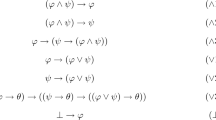Abstract
In this paper we present a fragment of (positive) relevant logic which can be computed by a straightforward extension to SLD resolution while allowing full nesting of implications. These two requirements lead quite naturally to a fragment in which the major feature is an ambiguous ‘user-level’ conjunction which is interpreted intensionally in ‘query’ positions and extensionally in ‘assertion’ positions. These restrictions allow a simple and efficient extension to SLD resolution (and more particularly, the PROLOG evaluation scheme) with quite minor loss in expressive power.
Similar content being viewed by others
References
Anderson A. R. and Belnap N. D.Jr.,Entailment: the Logic of Relevance and Necessity, Vol. 1, Princeton University Press, Princeton (1975).
Batens Diderik, ‘Static and dynamic paraconsistent logics’,CC-AI,3, 1–2 (1986).
Belnap, N. D., Jr., ‘How a computer should think’, InContemporary Aspects of Philosophy, Oxford (1977).
Belnap, N. D., Jr., ‘A useful four valued logic’, In G. Epstein and J. M. Dunn (eds.),Modern Uses of Multiple-Valued Logic, Reidel (1977).
Bollen, A. W., ‘A relevant reasoner’, Research Paper No 18, Logic Group, Research School of Social Sciences, Australian National University (1985).
Bollen, A. W., ‘A Relevant Extension to PROLOG’, Technical Report TR-ARP-15/87, Automated Reasoning Project, Australian National University (1987).
Bollen, A. W., ‘Conditional Logic Programming’, Ph.D. Thesis, The Australian National University (1988).
Blair, H. A. and Subrahmanian, V. S., ‘Paraconsistent logic programming’, InSpringer Lecture Notes in Computer Science Vol. 287, Springer-Verlag (1987).
Dunn, J. M., ‘The algebra of intensional logics’, Ph.D. Thesis, University of Pittsburgh (1966).
Dunn, J. M., ‘Relevance logic and entailment’, In D. Gabbay and F. Guenthner (eds.),Handbook of Philosophical Logic Vol. III, Reidel (1986).
Girard J.-Y., ‘Linear logic’,Theoretical Computer Science,50, 1–101 (1987).
Gabbay D. M. and Reyle U., ‘N-PROLOG: an extension to PROLOG with hypothetical implications, I’,Journal of Logic Programming,4, 319–355 (1984).
Hogger, Christopher Joyn,Introduction to Logic Programming, Academic Press (1984).
Lloyd, J. W.,Foundations of Logic Programming, Springer-Verlag (1984).
Lloyd J. W. and Topor R. W., ‘Making PROLOG more expressive’,Journal of Logic Programming,3, 225–240 (1984).
Lloyd J. W. and Topor R. W., ‘A basis for deductive database systems’,Journal of Logic Programming,2, 93–109 (1985).
Meyer, R. K., ‘Intuitionism, entailment, negation’, In H. Leblanc (ed.)Truth, Syntax and Modality, North Holland (1972).
Meyer, R. K., ‘A Boolean valued semantics for R’, Research Paper No. 4, Logic Group, Research School of Social Sciences, Australian National University (1979).
Mitchell, John C. and O'Donnell, Michael J. ‘Realizability semantics for error-tolerant logics’, InProc. 1986 Symposium on Theoretical Aspects of Reasoning About Knowledge, Morgan Kauffman (1986).
Meyer, R. K. and Routley, Richard, ‘Algebraic analysis of entailment, I’,Logique et Analyse,15 (1972).
Martins, J. P. and Shapiro, Stuart C., ‘Theoretical foundations for belief revision’, InProc. 1986 Symposium on Theoretical Aspects of Reasoning About Knowledge, Morgan Kauffman (1986).
Robinson, J. A.,Logic: Form and Function, Edinburgh University Press (1979).
Sylvan, R., Meyer, R. K., Plumwood, V. and Brady, R. T.,Relevant Logics and their Rivals I, Ridgeview (1982).
Shapiro, Stuart C. and Wand, Mitchell, ‘The Relevance of Relevance’, Technical Report 46, Computer Science Department, Indiana University (1976).
Tennant, Neil, ‘Perfect validity, entailment and paraconsistency’,Studia Logica,XLIII (1/2) (1984).
Thistlewaite, P. B., McRobbie, M. A. and Meyer, R. K.,Automated Theorem Proving in Non-Classical Logics, Pitman (1988).
Author information
Authors and Affiliations
Rights and permissions
About this article
Cite this article
Bollen, A.W. Relevant logic programming. J Autom Reasoning 7, 563–585 (1991). https://doi.org/10.1007/BF01880329
Received:
Accepted:
Issue Date:
DOI: https://doi.org/10.1007/BF01880329




